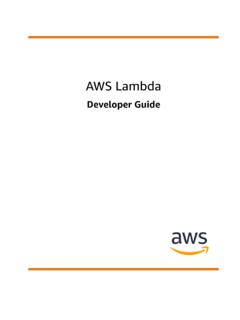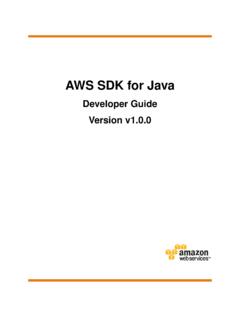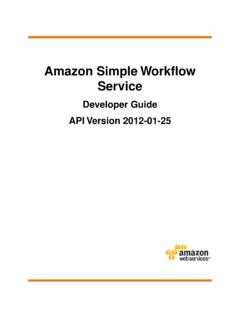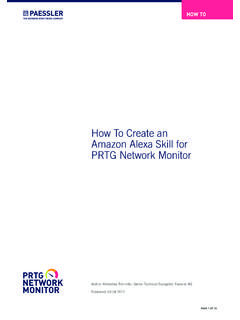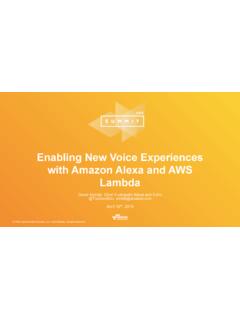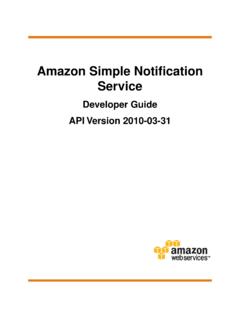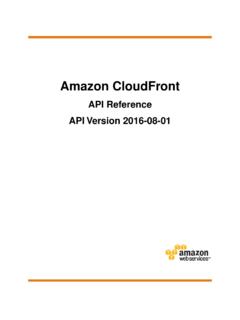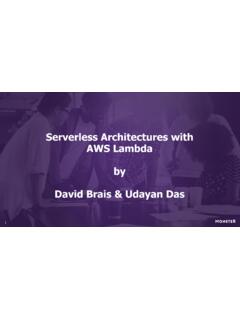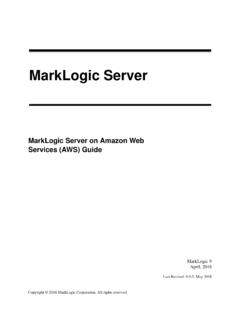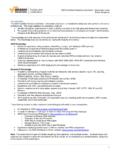Transcription of Hybrid Cloud DNS Solutions for Amazon VPC
1 Hybrid Cloud DNS Options for Amazon VPC November 2019 Notices Customers are responsible for making their own independent assessment of the information in this document. This document: (a) is for informational purposes only, (b) represents current AWS product offerings and practices, which are subject to change without notice, and (c) does not create any commitments or assurances from AWS and its affiliates, suppliers, or licensors. AWS products or services are provided as is without warranties, representations, or conditions of any kind, whether express or implied. The responsibilities and liabilities of AWS to its customers are controlled by AWS agreements, and this document is not part of, nor does it modify, any agreement between AWS and its customers.
2 2019 Amazon Web services , Inc. or its affiliates. All rights reserved. Contents Introduction .. 1 Key Concepts .. 1 Constraints .. 6 Solutions .. 7 Route 53 Resolver Endpoints and Forwarding Rules .. 7 Secondary DNS in an Amazon VPC .. 11 Decentralized Conditional Forwarders .. 13 Scaling DNS Management Across Multiple Accounts and VPCs .. 18 Selecting the Best Solution for Your Organization .. 22 Additional 23 DNS Logging .. 23 Custom EC2 DNS Resolver .. 25 Microsoft Windows Instances .. 27 Unbound Additional Options .. 28 DNS Forwarder Forward First .. 28 DNS Server 28 Conclusion .. 30 Contributors .. 30 Document 31 Abstract The Domain Name System (DNS) is a foundational element of the internet that underpins many services offered by Amazon Web services (AWS).
3 Amazon Route 53 Resolver provides resolution with DNS for public domain names, Amazon Virtual Private Cloud ( Amazon VPC), and Route 53 private hosted zones. This whitepaper includes Solutions and considerations for advanced DNS architectures to help customers who have workloads with unique DNS requirements, or on-premises resources that require DNS resolution between on-premises data centers and Amazon EC2 instances in Amazon Web services Hybrid Cloud DNS Options for Amazon VPC 1 Introduction Many organizations have both on-premises resources and resources in the Cloud . DNS name resolution is essential for on-premises and Cloud -based resources. For customers with Hybrid workloads, which include on-premises and Cloud -based resources, extra steps are necessary to configure DNS to work seamlessly across both environments.
4 AWS services that require name resolution could include Elastic Load Balancing load balancer (ELB), Amazon Relational Database Service ( Amazon RDS), Amazon Redshift, and Amazon Elastic Compute Cloud ( Amazon EC2). Route 53 Resolver, which is available in all Amazon VPCs, responds to DNS queries for public records, Amazon VPC resources, and Route 53 private hosted zones (PHZs). You can configure it to forward queries to customer managed authoritative DNS servers hosted on-premises, and to respond to DNS queries that your on-premises DNS servers forward to your Amazon VPC. This whitepaper illustrates several different architectures that you can implement on AWS using native and custom-built Solutions .
5 These architectures meet the need for name resolution of on-premises infrastructure from your Amazon VPC and address constraints that have only been partially addressed by previously published Solutions . Key Concepts Before we dive into the Solutions , it is important to establish a few concepts and configuration options that we ll reference throughout this whitepaper. Amazon VPC DHCP Options Set The Dynamic Host Configuration Protocol (DHCP) provides a standard for passing configuration information to hosts on a TCP/IP network. The options field of a DHCP message contains configuration parameters such as domain-name-servers, domain-name, ntp-servers, and netbios-node-type.
6 In any Amazon VPC, you can create DHCP options sets and specify up to four DNS servers. Currently, these options sets are created and applied per VPC, which means that you can t have a DNS server list at the Availability Zone level. For more information about DHCP options sets and configuration, see Overview of DHCP Option Sets in the Amazon VPC developer Amazon Web services Hybrid Cloud DNS Options for Amazon VPC 2 Amazon Route 53 Resolver Route 53 Resolver, also known as the Amazon DNS Server or Amazon Provided DNS, provides full public DNS resolution, with additional resolution for internal records for the VPC and customer-defined Route 53 private DNS Route 53 Resolver maps to a DNS server running on a reserved IP address at the base of the VPC network range, plus two.
7 For example, the DNS Server on a network is located at For VPCs with multiple CIDR blocks, the DNS server IP address is located in the primary CIDR block. Elastic Network Interfaces (ENIs) Elastic network interfaces (referred to as network interfaces in the Amazon EC2 console) are virtual network interfaces that you can attach to an instance in a VPC. They re available only for instances running in a VPC. A virtual network interface, like any network adapter, is the interface that a device uses to connect to a network. Each instance in a VPC, depending on the instance type, can have multiple network interfaces attached to it. For more information, see Elastic Network Interfaces in the Amazon EC2 User guide for Linux How ENIs Work for Route 53 Resolver A Route 53 Resolver endpoint is made up of one or more ENIs, which reside in your VPC.
8 Each endpoint can only forward queries in a single direction. Inbound endpoints are available as forwarding targets for DNS resolvers and use an IP address from the subnet space of the VPC to which it is attached. Queries forwarded to these endpoints have the DNS view of the VPC to which the endpoints are attached. Meaning, if there are names local to the VPC, such as AWS PrivateLink endpoints, EFS clusters, EKS clusters, PHZs associated, etc. the query can resolve any of those names. This is also true for any VPCs peered with the VPC, which owns the endpoint. Outbound endpoints serve as the path through which all queries are forwarded out of the VPC. Outbound endpoints are directly attached to the owner VPC and indirectly associated with other VPCs via rules.
9 Meaning, if a forwarding rule is shared with VPC that does not own the outbound endpoint, all queries that match the forwarding rule pass through to the owner VPC and then forward out. It is important to realize this when using queries to forward from one VPC to another. The outbound endpoint may reside in an entirely different Availability Zone than the VPC that originally sent the query, and there is potential for an Availability Zone outage in the owner VPC to impact query Amazon Web services Hybrid Cloud DNS Options for Amazon VPC 3 resolution in the VPC using the forwarding rule. This can be avoided by deploying outbound endpoints in multiple Availability Zones. Figure 1: Route 53 Resolver with Outbound Endpoint See Getting Starting with Route 53 Resolver in the Amazon Route 53 developer guide for more information.
10 Route 53 Private Hosted Zone A Route 53 private hosted zone is a container that holds DNS records that are visible to one or more VPCs. VPCs can be associated to the private hosted zone at the time of (or after) the creation of the private hosted zone. For more information, see Working with Private Hosted Zones in the Amazon Route 53 developer Connection Tracking By default, Amazon EC2 security groups use connection tracking to track information about traffic to and from the Security group rules are applied based on the connection state of the traffic to determine if the traffic is allowed or denied. This allows security groups to be stateful, which means that responses to inbound traffic are allowed to flow out of the instance regardless of outbound security group rules, and vice versa.










